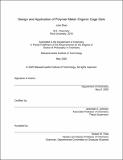Design and application of polymer metal-organic cage gels
Author(s)
Zhao, Julia.
Download1192965986-MIT.pdf (15.76Mb)
Other Contributors
Massachusetts Institute of Technology. Department of Chemistry.
Advisor
Jeremiah A. Johnson.
Terms of use
Metadata
Show full item recordAbstract
Chapter 1. A unifying overview of the fundamentals of polymer network synthesis, structure, and properties is provided, tying together recent trends in the field that are not always associated with classical polymer networks, such as the advent of crystalline "framework" materials. Recent advances in using molecular design and control of topology showcase how a deep understanding of structure-property relationships can lead to advanced networks with exceptional properties. Chapter 2. A novel bispyridine-based M₆L₁₂ coordination cube inspired by related work from Fujita and coworkers is prepared and used to generate a polyMOC gel with intermediate branch functionality compared to previous polyMOC networks. The ligand is able to successfully self-assemble with not only Pd(II) and Pt(II), but also combinations of both metals to form mixed-metal cages. Through adjusting the ratio of palladium and platinum metal salts incorporated into network assembly, we can tune the energy dissipation properties of these materials due to differences in lability of metal-pyridine coordination bonds. Using this strategy, the characteristic relaxation times and loss moduli of these M₆L₁₂-based gels can be tuned over nearly three orders of magnitude while maintaining the general network topology as well as the elastic behavior of the material. Chapter 3. The M₁₂L₂₄-based polyMOC network was optimized for water purification and reuse. A library of ligands was designed and synthesized to target three different chemical families: aromatic, perfluorinated, and alkylated groups. PolyMOC gel purification performance was tested for aromatic compounds and perfluoroalkyl substances (PFAS). These evaluations demonstrated some successes in the absorption of selected model compounds; however, absorption in all cases were accompanied with nonspecific binding of unfunctionalized control gels. Potential absorption mechanisms contributing to this nonspecific binding are discussed. Future work to better determine interaction mechanisms are necessary for improved design and function of polyMOC gels towards water treatment applications.
Description
Thesis: Ph. D., Massachusetts Institute of Technology, Department of Chemistry, May, 2020 Cataloged from the official PDF of thesis. Includes bibliographical references.
Date issued
2020Department
Massachusetts Institute of Technology. Department of ChemistryPublisher
Massachusetts Institute of Technology
Keywords
Chemistry.